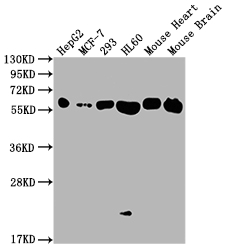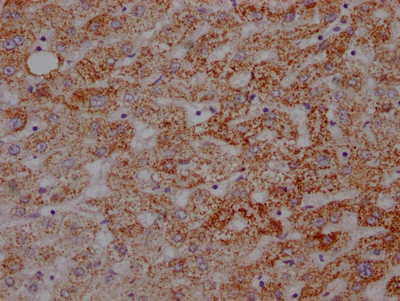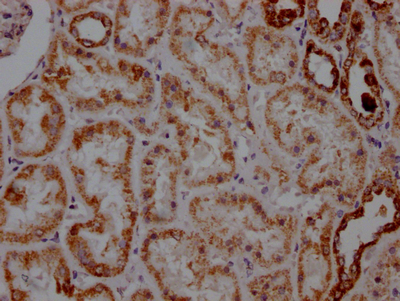
Western Blot Positive WB detected in: HepG2 whole cell lysate, MCF-7 whole cell lysate, 293 whole cell lysate, HL60 whole cell lysate, Mouse Heart tissue, Mouse Brain tissue All lanes: ATP5F1A antibody at 1:2000 Secondary Goat polyclonal to rabbit IgG at 1/50000 dilution Predicted band size: 60, 55, 58 kDa Observed band size: 60 kDa
ATP5A1 Recombinant Monoclonal Antibody
CSB-RA159926A0HU
ApplicationsWestern Blot, ELISA, ImmunoHistoChemistry
Product group Antibodies
ReactivityHuman, Mouse
TargetATP5F1A
Overview
- SupplierCusabio
- Product NameATP5A1 Recombinant Monoclonal Antibody
- Delivery Days Customer20
- ApplicationsWestern Blot, ELISA, ImmunoHistoChemistry
- CertificationResearch Use Only
- ClonalityMonoclonal
- Clone ID5G11
- ConjugateUnconjugated
- Gene ID498
- Target nameATP5F1A
- Target descriptionATP synthase F1 subunit alpha
- Target synonymsATP synthase alpha chain, mitochondrial; ATP synthase subunit alpha, mitochondrial; ATP synthase, H+ transporting, mitochondrial F1 complex, alpha subunit 1, cardiac muscle; ATP sythase (F1-ATPase) alpha subunit; ATP5A; ATP5A1; ATP5AL2; ATPM; COXPD22; epididymis secretory sperm binding protein Li 123m; hATP1; HEL-S-123m; MC5DN4; mitochondrial ATP synthetase, oligomycin-resistant; MOM2; OMR; ORM
- IsotypeIgG
- Protein IDP25705
- Protein NameATP synthase subunit alpha, mitochondrial
- Scientific DescriptionMitochondrial membrane ATP synthase (F(1)F(0) ATP synthase or Complex V) produces ATP from ADP in the presence of a proton gradient across the membrane which is generated by electron transport complexes of the respiratory chain. F-type ATPases consist of two structural domains, F(1) - containing the extramembraneous catalytic core, and F(0) - containing the membrane proton channel, linked together by a central stalk and a peripheral stalk. During catalysis, ATP synthesis in the catalytic domain of F(1) is coupled via a rotary mechanism of the central stalk subunits to proton translocation. Subunits alpha and beta form the catalytic core in F(1). Rotation of the central stalk against the surrounding alpha(3)beta(3) subunits leads to hydrolysis of ATP in three separate catalytic sites on the beta subunits. Subunit alpha does not bear the catalytic high-affinity ATP-binding sites (By similarity).
- ReactivityHuman, Mouse
- Storage Instruction-20°C or -80°C
- UNSPSC12352203


